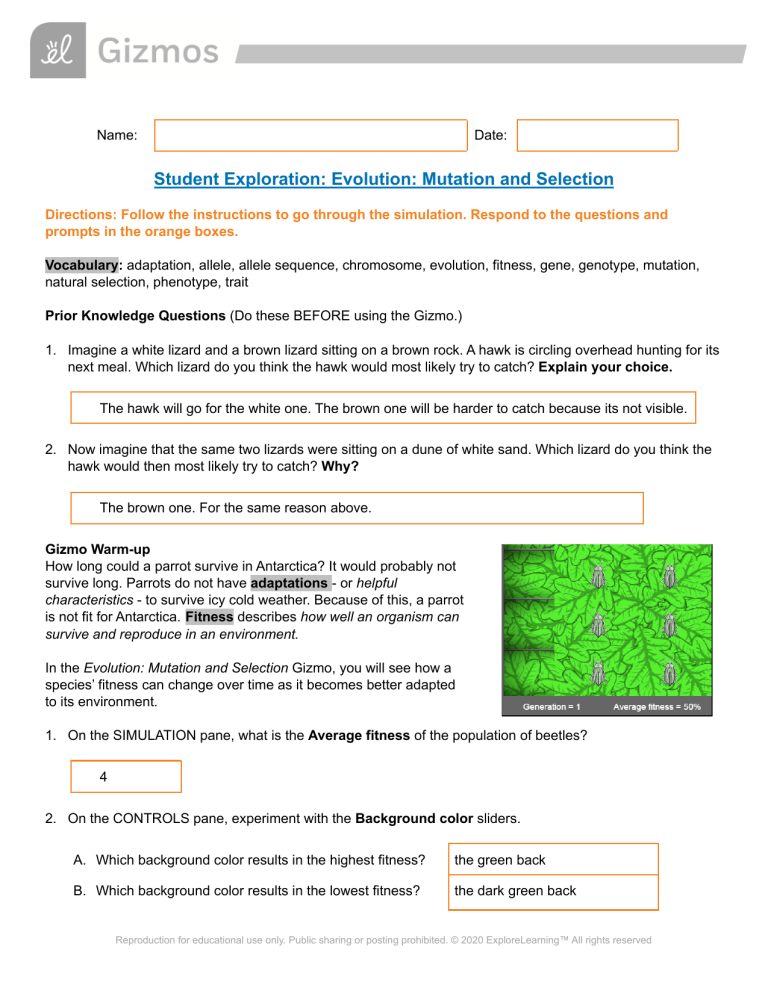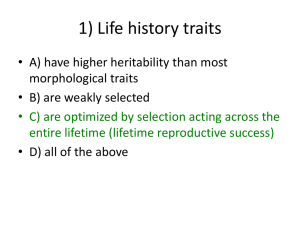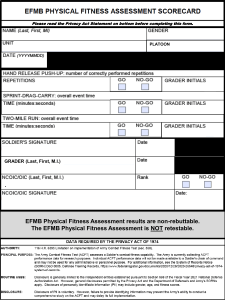
Name: Date: Student Exploration: Evolution: Mutation and Selection Directions: Follow the instructions to go through the simulation. Respond to the questions and prompts in the orange boxes. Vocabulary: adaptation, allele, allele sequence, chromosome, evolution, fitness, gene, genotype, mutation, natural selection, phenotype, trait Prior Knowledge Questions (Do these BEFORE using the Gizmo.) 1. Imagine a white lizard and a brown lizard sitting on a brown rock. A hawk is circling overhead hunting for its next meal. Which lizard do you think the hawk would most likely try to catch? Explain your choice. The hawk will go for the white one. The brown one will be harder to catch because its not visible. 2. Now imagine that the same two lizards were sitting on a dune of white sand. Which lizard do you think the hawk would then most likely try to catch? Why? The brown one. For the same reason above. Gizmo Warm-up How long could a parrot survive in Antarctica? It would probably not survive long. Parrots do not have adaptations - or helpful characteristics - to survive icy cold weather. Because of this, a parrot is not fit for Antarctica. Fitness describes how well an organism can survive and reproduce in an environment. In the Evolution: Mutation and Selection Gizmo, you will see how a species’ fitness can change over time as it becomes better adapted to its environment. 1. On the SIMULATION pane, what is the Average fitness of the population of beetles? 4 2. On the CONTROLS pane, experiment with the Background color sliders. A. Which background color results in the highest fitness? the green back B. Which background color results in the lowest fitness? the dark green back Reproduction for educational use only. Public sharing or posting prohibited. © 2020 ExploreLearning™ All rights reserved Activity A: Inherited variation Get the Gizmo ready: ● Set Red to 100, Green to 255, and Blue to 50. Introduction: An organism’s traits, or characteristics, are controlled by genes. Genes are located on rod-like structures called chromosomes. Different versions of genes that code for the same trait are called alleles. In this Gizmo, there are 3 genes on each chromosome. For each gene there are eight possible alleles: W (white), R (red), G (green), B (blue), C (cyan), M (magenta), Y (yellow), and K (black). Question: Where does variation in a population come from? 1. Observe: Click on one of the insects. The two rod-like structures under Genotype on the left side of the Gizmo represent chromosomes. The three letters next to each chromosome represent alleles. Which alleles does the insect have? It’s the W, G, B, W, W, G. The alleles carried on an organism’s chromosomes make up the organism’s genotype. 2. Observe: An organism’s alleles combine to produce a trait. The physical expression of that trait is a phenotype. In this Gizmo, phenotype is expressed in red, green, and blue values. A. What is the phenotype of the insect? B. What color is the insect? Red: B Green: W Blue: B Green 3. Run Gizmo: Move the Sim. speed slider all the way to the left. Click Play ( ). You will see the insects move to the left in pairs. The pairs mate and produce a set of four offspring. As soon as you see at least one offspring with an oval around it, click Pause ( ). Click on the circled offspring. A. What is its genotype? (3 pairs) W,G,B B. What is its phenotype The recessive. C. How does its genotype and phenotype differ from the non-circled offspring? From the dominant traits. 4. Explain: The change in the circled offspring’s genotype was caused by a mutation. A mutation is a change in a gene. Mutations happen when a mistake is made when a cell’s chromosomes are copied. How might mutations introduce variation into a population? It will change the genes by adding population. Reproduction for educational use only. Public sharing or posting prohibited. © 2020 ExploreLearning™ All rights reserved 5. Collect data: Move the Mutation rate slider to 3.0, and click Play. Allow the Gizmo to run for another 10–15 generations. (You can see the generation number below the insects.) Click Pause when the parents are ready to have offspring. Find two parents that have at least two new alleles each. (If you can’t find any, allow the Gizmo to run a few more generations and try again.) Write the allele sequences (top to bottom) for these parents in the table below. Note the labels for each of these chromosomes: A1, A2, B1, and B2. 1 2 Organism: Parent A Parent B Allele sequence of chromosome 1: (A1) (B1) Allele sequence of chromosome 2: (A2) (B2) Click Play, and then click Pause immediately after the offspring are produced. Write the allele sequences of chromosomes 1 and 2 for each of the offspring of your selected parents. Offspring Allele sequence of chromosome 1 Offspring 1 ( A1 Offspring 2 ( Offspring 3 ( A3 Offspring 4 ( A4 Allele sequence of chromosome 2 ) ( A5 ) A2 ) ( A6 ) ) ( A7 ) ) ( A8 ) Label the offspring chromosomes A1, A2, B1, or B2. Circle any mutated chromosomes. 6. Analyze: Study the completed table. A. Look at the inheritance patterns. What do you notice? I notice that they grow. B. Can a single offspring inherit both chromosomes from one parent? Explain: No they cannot. C. Did any mutations occur in this set of offspring? If so, which chromosome mutated? No. 7. Challenge yourself: You have already learned that mutation is one source of variation in a population. Based on what you have just seen, what is a second source of variation? A second source of variation is the way they connect and bond. Reproduction for educational use only. Public sharing or posting prohibited. © 2020 ExploreLearning™ All rights reserved Activity B: Survival of the fittest Get the Gizmo ready: ● Click Reset ( ). ● Set Red to 255, Green to 0, and Blue to 130. ● Set the Mutation rate to 1.0. Question: Are some organisms more likely to survive and reproduce than others? 1. Count: Move the Sim. speed slider all the way to the left. Click Play. A. After the parents mate, click Pause. How many offspring are there? 2 B. Click Play. After the birds eat, click Pause. How many offspring are left? 1 In nature, as in the Gizmo, more offspring are born than can survive long enough to reproduce. Because of this, the offspring must compete with one another for survival. In this Gizmo, the insect offspring compete to avoid being eaten by birds. 2. Observe: Move the Sim. speed slider one notch to the right. Click Play, and wait for about 20 generations to pass. You should see a variety of insect phenotypes. (If not, click Play and wait until you do.) A. What different colors of insects do you see? 6 B. How do you think this variation might affect the competition between the offspring? I think it might change the offspring. 3. Analyze: Click on a few beetles and note their fitness (shown under the Phenotype). The fitness of an organism reflects how likely it is to survive and produce offspring. Each insect is given a percentage that reflects its chances of surviving to reproduce. Compare the fitness percentages to the insect colors. How does fitness relate to the color of the insects? They relate by the way the insects genes mutate. 4. Predict: How do you think an insect’s fitness will affect its chances of being eaten by birds? It would be harder to eat. Reproduction for educational use only. Public sharing or posting prohibited. © 2020 ExploreLearning™ All rights reserved 5. Collect data: In nature, chance alone can affect whether an individual survives. However, general trends in survival rates can be seen by studying a larger group of individuals. Move the Sim. speed slider all the way to the left. Click Play, and then click Pause when all the offspring are visible. Write the generation number and the average fitness of all the offspring in the first two spaces of the table below. Next, click Play, and then click Pause immediately after the birds have fed and the 10 survivors are visible. Mouse over each survivor and record its fitness. Find the average fitness of the survivors by adding these values and dividing by 10. Repeat this experiment two more times, recording your results in the table. Generation Ave. fitness Survivor fitness values Ave. survivor fitness 1 Strong 9/10 90 2 Little Weaker 7/10 70 3 Strongish 8/10 80 6. Recognize trends: Study the table above. What trends do you see? I see connections in the bonds. 7. Analyze: In most situations, were the fittest insects or the least fit insects most likely to survive? Explain how the data from your experiment supports your answer. The most fittest. 8. Think and discuss: The principle of natural selection states that the best adapted organisms are most likely to survive and reproduce. Was this demonstrated in your experiment? Explain. No it was not demonstrated. Reproduction for educational use only. Public sharing or posting prohibited. © 2020 ExploreLearning™ All rights reserved Get the Gizmo ready: Activity C: ● Click Reset. Set Red to 100, Green to 255, and Blue to 50. Evolution Introduction: You learned in activity B that fit individuals have a better chance of surviving and reproducing than individuals that are less fit. In this activity, you will observe how natural selection affects a population over time. Question: How does a population change over time? 1. Experiment: Set the Background color to the values shown in the last column of the table below. Record the Average fitness of generation 1 in the second column of the table. Move your cursor over the insects and find the individual with the greatest fitness. (In the first generation, all the insects will have the same fitness). Record that individual’s phenotype in the table’s third column. Move the Sim. speed slider a quarter of the way to the right. Run the Gizmo, and complete the table for each listed generation. (The generation number does not have to be exact.) Generation number Average Fitness Fitness of Fittest Individual Phenotype of Fittest Individual (R, G, B) 1 0 0 G 25 1/4 25 B 50 2/4 50 R 75 3/4 75 B 100 4/4 100 R 150 1 2/4 150 R 200 8/4 200 G 300 10/4 300 B Background color red = 100 green = 255 blue = 50 2. Describe: Examine the data collected for trends. A. How did the phenotype of the fittest individual change over time? It increased B. How did the population’s fitness change over time? It decreases The process by which populations change over time is known as evolution. This Gizmo only demonstrates how one trait—body color—can evolve. Reproduction for educational use only. Public sharing or posting prohibited. © 2020 ExploreLearning™ All rights reserved 3. Predict: Based on what you have just seen, how do you think the population will evolve if you made the Background color purple? It would change. 4. Test: Set Red to 120, Green to 0, and Blue to 160 to make a purple background. Click Play. After 300 more generations have passed, click Pause. Was your prediction correct? Explain. Yes it was correct it looked the way I predicted. Very similar. 5. Make connections: Why do you think it is necessary for there to be variation in a population in order for evolution by natural selection to occur? So that they can evolve. 6. Make connections: Why is it necessary for traits to be inherited for evolution to take place? So they can all evolve properly. 7. Apply: Look carefully at the picture below and you will see an insect called a katydid. Katydids evolved from grasshoppers through natural selection. Use what you have learned to explain how this could have happened. The weakest died. Reproduction for educational use only. Public sharing or posting prohibited. © 2020 ExploreLearning™ All rights reserved




